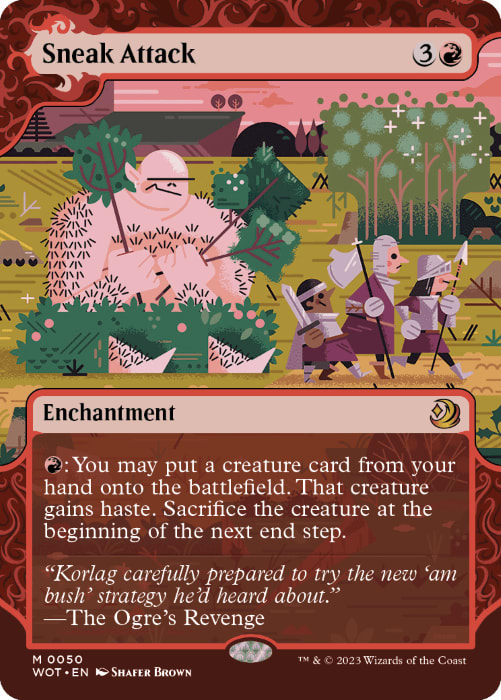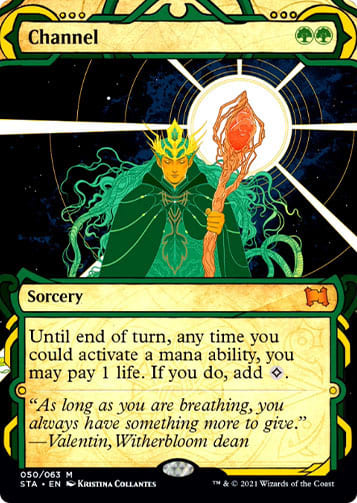
One of the most thrilling and high-powered archetypes in Cube is "Sneak & Show", a fast and explosive archetype that revolves around getting large, game-altering creatures into play before your opponent has a chance to react. With powerful cards like Sneak Attack, Show and Tell, and Channel, "Sneak & Show" is a perfect fit for players who love to cheat massive creatures into play and end the game quickly. This guide will explore the fundamentals of the Sneak & Show archetype, its core cards, and the strategies that make it one of the most exciting archetypes in Cube.
What is Sneak & Show?
The "Sneak & Show" archetype is all about bypassing the traditional method of casting big creatures via a straightforward mana cost. Instead, the archetype seeks to cheat these creatures into play using a combination of spells that allow players to circumvent casting costs. The core gameplay revolves around two primary strategies: Sneak Attack and Show and Tell, both of which enable players to put a huge threat into play far ahead of schedule. The key is to maximize the value of these cards by filling your deck with high-impact creatures - preferably ones that have immediate and game-changing effects.
Enablers
Sneak Attack is an enchantment that allows you to put any creature from your hand directly onto the battlefield (with haste) by paying a single Red mana. At the end of the turn, the creature is sacrificed. The sheer speed of Sneak Attack is what makes it so powerful. You can drop a huge creature like Griselbrand, or Emrakul, the Aeons Torn, and take immediate advantage of their powerful abilities.
While the creature will be sacrificed at the end of the turn, in most cases, the game will have ended by then. Sneak Attack lets you set up explosive turns where you're casting creatures far ahead of the curve and creating huge board states with very little setup. For example, dropping an Inferno Titan or Blightsteel Colossus can give you an enormous swing in just one turn. The risk of losing the creature at the end of the turn is often a non-issue if you can end the game before that happens.
The other pillar of the archetype, Show and Tell is a sorcery that lets both players put a permanent into play from their hands for just three mana - one of the most exciting ways to cheat creatures into play. While this card does allow your opponent to put a permanent into play, it is generally not an issue if you're already planning on putting a massive, game-altering creature into play. Unlike Sneak Attack, Show and Tell doesn't sacrifice the creature at the end of the turn, and allows you to put other game winning permanents like Omniscience into play.
The secret third key card in the archetype is Channel, which allows you to pay any amount of life to add that much colorless mana to your mana pool. This ability gives you an immediate way to cast the most expensive creatures in Magic. For example, you could use Channel to put out a creature like Emrakul, the Aeons Torn or Ulamog, the Ceaseless Hunger as early as turn one or two, completely outpacing your opponent's ability to interact with these threats.
Honorable Mentions
Though they are not as popular as the namesake cards, this archetype has access to a variety of similar effects for all budgets and power levels. Cards such as: Elvish Piper, Through the Breach, Ilharg, the Raze-Boar, Tooth and Nail, and Eureka to name a few.
Building a Sneak & Show Deck
Sneak & Show requires careful deck-building to maximize the effectiveness of your key spells. While the primary focus is on high-power creatures and mana acceleration, the deck also needs to balance consistency and speed. Here are some important considerations when building your Sneak & Show Cube deck.
Key Creatures
The creatures you choose for this archetype need to have high power, strong ETB effects, or be capable of ending the game quickly. Some of the best choices include:
- Griselbrand - Due to its powerful draw ability, resolving a Griselbrand off of Sneak Attack, usually means you can draw into more threats to finish the game.
- Emrakul, the Aeons Torn - Whether you cast her, attack with her, or just put her into play, Emrakul ends the game promptly due to her protection and unreal stats.
- Blightsteel Colossus - effectively changes your opponent's life total to 10 and can be cast directly off of Channel.
Supporting Cards
To maximize the effectiveness of your enablers, you'll want additional ways to ensure consistency and protect your threats.
- Brainstorm - As one of the best ways to manipulate the top of your deck, Brainstorm can help you set up the perfect Show and Tell or Sneak Attack play.
- Force of Will - A reliable counterspell to protect your combo, Force of Will ensures that you can keep your plan intact when facing counterspells or removal.
- Lotus Petal and Simian Spirit Guide - Mana acceleration is crucial in the Sneak & Show archetype, as it helps you power out your threats early.
How to Play Sneak & Show
The gameplay for Sneak & Show is fast and aggressive, focusing on putting pressure on your opponent from the very beginning. It is recommended that you mulligan until you see at least one piece of the combo and cards that help you find the other. The key to success with Sneak & Show is understanding when to commit to your plan, and how it might go wrong. So, I'll leave you with 3 pointers on how to play your enablers correctly.
Sneak Attack - Ask yourself if you can wait an additional turn to play this spell. Timing is key, and the difference between playing Sneak Attack and activating it on the same turn is often the difference between winning and losing.
Show and Tell - What is your opponent playing? In a dreamworld, you reveal a game ending creature and your opponent reveals Savannah Lions. Knowing what deck your opponent is playing is crucial to timing this card. Thoughtseize and similar effects can help clear the way to ensure you're the only one putting a game ending card into play.
Channel - The life loss is real. Metalwork Colossus looks like a great budget alternative to Blightsteel Colossus, but it "Dies to Doom Blade" and even more embarrassing dies to Disenchant. Resolving a big threat only matters if it sticks around and going down multiple cards and life is generally a bad way to start the game.



























